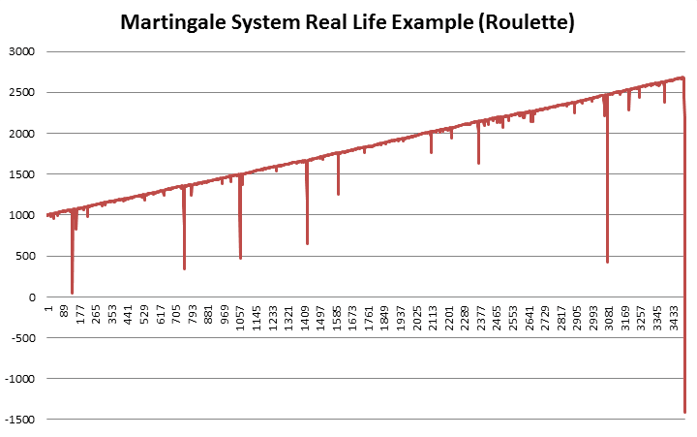The Martingale System is one of the oldest and most famous betting systems out there and whilst it may seem to hold so much promise thanks to its simplicity, unfortunately it is doomed to fail. The Martingale System is primarily used for roulette but can be applied to any game where you have a roughly 50/50 chance of winning on a given go or turn. It is so simple and seems so sure to work that many people have “invented” it themselves, stumbling across the idea through their own play, winning over a short period and assuming they have discovered the holy grail of betting, a fool proof, infallible scheme.
This system, and other variants, sprung to prominence in France in the 1700s and have captivated many a punter since. The Martingale System is an example of a negative progression staking plan whereby when you lose you double your stake for the next hand/spin/coin toss.
So, if you lose £1, you bet £2, if you lose again you bet £4, if you lose again you bet £8 at which point a win means you lost £7 but won £8 and so are £1 up. By doubling your stake in this way you will always end one unit (be it a £1, £10 or £1,000) in net after any win, no matter how many losses preceded it.
| Bet | Win | Cumulative Stake | Net Win |
|---|---|---|---|
| £1 | £2 | £1 | £1 |
| £2 | £4 | £3 | £1 |
| £4 | £8 | £7 | £1 |
| £8 | £16 | £15 | £1 |
| £16 | £32 | £31 | £1 |
| £32 | £64 | £63 | £1 |
| £64 | £128 | £127 | £1 |
| £128 | £256 | £255 | £1 |
| £256 | £512 | £511 | £1 |
| £512 | £1024 | £1023 | £1 |
So far so good? Well, maybe, and in a hypothetical world where you had unlimited funds, unlimited time, a casino that would accept any stake and Herculean bravery the system would indeed work. However, unless you can tick all four of those requirements the Martingale System is, quite simply, one of the worst betting systems imaginable and doomed to failure.
In the short term it may well deliver a number of small wins and these could go on for days, weeks or even longer. However, at some stage a run of losses will come along that will wipe out the player’s bank and this devastating loss will be larger – and probably considerably larger – than all the previous accumulated wins. And there is, of course, no way of knowing when the crippling loss will occur.

Assuming you play with a £1 stake and bet on black each time on roulette, eventually a long run of reds will hit that will be unsustainable. After eight reds in a row your next stake is £256 (and you are £255 down) whilst just three more reds sees you staking £2048 on a single spin. Clearly this is far more than most people can afford to lose and considering this risk is undertaken in order to win just £1 it’s easy to see why the system is doomed.
More importantly though, such a devastating sequence is far more likely than many players – especially those sucked in by the scheme – imagine. The chances of getting eight spins without a black are around 1 in 206 and much as you like to think it won’t happen… it will.
Because the existence of the zero in roulette gives the house an advantage (they pay out at even money on a colour but the zero means the chances are not one in two but 18 in 37) any betting system is subject to that house edge. A staking scheme cannot alter that or swing the odds in your favour, it simply alters the pattern of your pay-outs and stakes, the overall loss over time being the same however you bet.
As such, advice on the Martingale System for any form of betting is simple and clear: don’t ever use it.
